DCUN1D1 Is an Essential Regulator of Prostate Cancer Proliferation and Tumour Growth That Acts through Neddylation of Cullin 1, 3, 4A and 5 and Deregulation of Wnt/Catenin Pathway
Abstract
1. Introduction
2. Materials and Methods
3. Results
3.1. DCUN1D1 Is Upregulated in Human Prostate Cancer Cell Lines and Primary Cancer Tissue Samples
3.2. Blockage of DCUN1D1 Inhibits Proliferation and Migration and Induces Apoptosis of Prostate Cancer Cells
3.3. DCUN1D1 Is a Key Regulator of Prostate Cancer Tumour Growth In Vivo
3.4. DCUN1D1 Interacts with CUL3, CUL4B, RBX1, CAND1 and RPS19 Proteins
3.5. Identification of Differentially Expressed Proteins upon DCUN1D1 Inhibition in Prostate Cancer Cells
3.6. DCUN1D1 Knockdown Decreases Global Neddylation, Ubiquitination and Expression of Neddylation Components Demonstrating That DCUN1D1 Shows Preferential Neddylation Activity of Cullin Proteins in PCa
3.7. The WNT Pathway Is Inhibited following Knockdown of DCUN1D1 in PCa
4. Discussion
5. Conclusions
Supplementary Materials
Author Contributions
Funding
Institutional Review Board Statement
Informed Consent Statement
Data Availability Statement
Conflicts of Interest
References
- Rawla, P. Epidemiology of Prostate Cancer. World J. Oncol. 2019, 10, 63–89. [Google Scholar] [CrossRef]
- Sung, H.; Ferlay, J.; Siegel, R.L.; Laversanne, M.; Soerjomataram, I.; Jemal, A.; Bray, F. Global Cancer Statistics 2020: GLOBOCAN Estimates of Incidence and Mortality Worldwide for 36 Cancers in 185 Countries. CA Cancer J. Clin. 2021, 71, 209–249. [Google Scholar] [CrossRef]
- Kim, A.Y.; Bommeljé, C.C.; Lee, B.E.; Yonekawa, Y.; Choi, L.; Morris, L.G.; Huang, G.; Kaufman, A.; Ryan, R.J.H.H.; Hao, B.; et al. SCCRO (DCUN1D1) Is an Essential Component of the E3 Complex for Neddylation. J. Biol. Chem. 2008, 283, 33211–33220. [Google Scholar] [CrossRef]
- Keuss, M.J.; Thomas, Y.; Mcarthur, R.; Wood, N.T.; Knebel, A.; Kurz, T. Characterisation of the Mammalian Family of DCN-Type NEDD8 E3 Ligases. J. Cell Sci. 2016, 129, 1441–1454. [Google Scholar] [CrossRef]
- Sarkaria, I.; O-Charoenrat, P.; Talbot, S.G.; Reddy, P.G.; Ngai, I.; Maghami, E.; Patel, K.N.; Lee, B.; Yonekawa, Y.; Dudas, M.; et al. Squamous Cell Carcinoma Related Oncogene/DCUN1D1 Is Highly Conserved and Activated by Amplification in Squamous Cell Carcinomas. Cancer Res. 2006, 66, 9437–9444. [Google Scholar] [CrossRef]
- Huang, S.; Liu, Z.; Jiang, F.; He, H.; Zhong, W. DCUN1D1 Promotes Tumour Progress in Prostate Cancer and Its Effect on DU145 in Vitro. J. Pak. Med. Assoc. 2021, 71, 473–478. [Google Scholar] [CrossRef]
- Zhang, Z.-H.; Li, J.; Luo, F.; Wang, Y.-S. Clinical Significance of SCCRO (DCUN1D1) in Prostate Cancer and Its Proliferation-Inhibiting Effect on Lncap Cells. Eur. Rev. Med. Pharmacol. Sci. 2017, 21, 4283–4291. [Google Scholar] [PubMed]
- Broderick, S.R.; Golas, B.J.; Pham, D.; Towe, C.W.; Talbot, S.G.; Kaufman, A.; Bains, S.; Huryn, L.A.; Yonekawa, Y.; Carlson, D.; et al. SCCRO Promotes Glioma Formation and Malignant Progression in Mice. Neoplasia 2010, 12, 476–484. [Google Scholar] [CrossRef] [PubMed]
- Yoo, J.; Lee, S.-H.; Lym, K.-I.; Park, S.Y.; Yang, S.-H.; Yoo, C.-Y.; Jung, J.-H.; Kang, S.-J.; Kang, C.-S. Immunohistochemical Expression of DCUN1D1 in Non-Small Cell Lung Carcinoma: Its Relation to Brain Metastasis. Cancer Res. Treat. 2012, 44, 57–62. [Google Scholar] [CrossRef] [PubMed]
- Wang, J.; Qian, J.; Hoeksema, M.D.; Zou, Y.; Espinosa, A.V.; Rahman, S.M.J.; Zhang, B.; Massion, P.P. Integrative Genomics Analysis Identifies Candidate Drivers at 3q26-29 Amplicon in Squamous Cell Carcinoma of the Lung. Clin. Cancer Res. 2013, 19, 5580–5590. [Google Scholar] [CrossRef]
- Jiang, Z.; Song, Q.; Zeng, R.; Li, J.; Li, J.; Lin, X.; Chen, X.; Zhang, J.; Zheng, Y. MicroRNA-218 Inhibits EMT, Migration and Invasion by Targeting SFMBT1 and DCUN1D1 in Cervical Cancer. Oncotarget 2016, 7, 45622–45636. [Google Scholar] [CrossRef]
- Xiao, J.; Li, G.; Zhou, J.J.; Wang, S.; Liu, D.; Shu, G.; Zhou, J.J.; Ren, F. MicroRNA-520b Functions as a Tumor Suppressor in Colorectal Cancer by Inhibiting Defective in Cullin Neddylation 1 Domain Containing 1 (DCUN1D1). Oncol. Res. Featur. Preclin. Clin. Cancer Ther. 2018, 26, 593–604. [Google Scholar] [CrossRef]
- Paccez, J.D.; Vasques, G.J.; Correa, R.G.; Vasconcellos, J.F.; Duncan, K.; Gu, X.; Bhasin, M.; Libermann, T.A.; Zerbini, L.F. The Receptor Tyrosine Kinase Axl Is an Essential Regulator of Prostate Cancer Proliferation and Tumor Growth and Represents a New Therapeutic Target. Oncogene 2013, 32, 689–698. [Google Scholar] [CrossRef]
- Wang, Y.; Singh, K.; Dizon, D.; Graves, T.; Amin, A.; Yakirevich, E. Immunohistochemical HER2 Score Correlates with Response to Neoadjuvant Chemotherapy in HER2-Positive Primary Breast Cancer. Breast Cancer Res. Treat. 2021, 186, 667–676. [Google Scholar] [CrossRef]
- Paccez, J.D.; Duncan, K.; Sekar, D.; Correa, R.G.; Wang, Y.; Gu, X.; Bashin, M.; Chibale, K.; Libermann, T.A.; Zerbini, L.F. Dihydroartemisinin Inhibits Prostate Cancer via JARID2/MiR-7/MiR-34a-Dependent Downregulation of Axl. Oncogenesis 2019, 8, 14. [Google Scholar] [CrossRef]
- Zerbini, L.F.; Wang, Y.; Czibere, A.; Correa, R.G.; Cho, J.-Y.Y.; Ijiri, K.; Wei, W.; Joseph, M.; Gu, X.; Grall, F.; et al. NF-Kappa B-Mediated Repression of Growth Arrest- and DNA-Damage-Inducible Proteins 45alpha and Gamma Is Essential for Cancer Cell Survival. Proc. Natl. Acad. Sci. USA 2004, 101, 13618–13623. [Google Scholar] [CrossRef]
- Gu, X.; Zerbini, L.F.; Otu, H.H.; Bhasin, M.; Yang, Q.; Joseph, M.G.; Grall, F.; Onatunde, T.; Correa, R.G.; Libermann, T.A. Reduced PDEF Expression Increases Invasion and Expression of Mesenchymal Genes in Prostate Cancer Cells. Cancer Res. 2007, 67, 4219–4226. [Google Scholar] [CrossRef]
- Rappsilber, J.; Mann, M.; Ishihama, Y. Protocol for Micro-Purification, Enrichment, Pre-Fractionation and Storage of Peptides for Proteomics Using StageTips. Nat. Protoc. 2007, 2, 1896–1906. [Google Scholar] [CrossRef]
- Yuen, T.; Wurmbach, E.; Pfeffer, R.L.; Ebersole, B.J.; Sealfon, S.C. Accuracy and Calibration of Commercial Oligonucleotide and Custom CDNA Microarrays. Nucleic Acids Res. 2002, 30, e48. [Google Scholar] [CrossRef]
- Li, C.; Wong, W.H. Model-Based Analysis of Oligonucleotide Arrays: Expression Index Computation and Outlier Detection. Proc. Natl. Acad. Sci. USA 2001, 98, 31–36. [Google Scholar] [CrossRef]
- Ramalho-Santos, M.; Yoon, S.; Matsuzaki, Y.; Mulligan, R.C.; Melton, D.A. “Stemness”: Transcriptional Profiling of Embryonic and Adult Stem Cells. Science 2002, 298, 597–600. [Google Scholar] [CrossRef] [PubMed]
- Kanehisa, M. KEGG: Kyoto Encyclopedia of Genes and Genomes. Nucleic Acids Res. 2000, 28, 27–30. [Google Scholar] [CrossRef] [PubMed]
- Kanehisa, M. Toward Understanding the Origin and Evolution of Cellular Organisms. Protein Sci. 2019, 28, 1947–1951. [Google Scholar] [CrossRef] [PubMed]
- Kanehisa, M.; Furumichi, M.; Sato, Y.; Kawashima, M.; Ishiguro-Watanabe, M. KEGG for Taxonomy-Based Analysis of Pathways and Genomes. Nucleic Acids Res. 2023, 51, D587–D592. [Google Scholar] [CrossRef] [PubMed]
- Oliveros, J.C. (2007–2015) Venny. An Interactive Tool for Comparing Lists with Venn’s Diagrams. Available online: https://bioinfogp.cnb.csic.es/tools/venny/index.html (accessed on 25 July 2021).
- Tyanova, S.; Temu, T.; Sinitcyn, P.; Carlson, A.; Hein, M.Y.; Geiger, T.; Mann, M.; Cox, J. The Perseus Computational Platform for Comprehensive Analysis of (Prote)Omics Data. Nat. Methods 2016, 13, 731–740. [Google Scholar] [CrossRef]
- Ashburner, M.; Ball, C.A.; Blake, J.A.; Botstein, D.; Butler, H.; Cherry, J.M.; Davis, A.P.; Dolinski, K.; Dwight, S.S.; Eppig, J.T.; et al. Gene Ontology: Tool for the Unification of Biology. The Gene Ontology Consortium. Nat. Genet. 2000, 25, 25–29. [Google Scholar] [CrossRef]
- Mi, H.; Muruganujan, A.; Ebert, D.; Huang, X.; Thomas, P.D. PANTHER Version 14: More Genomes, a New PANTHER GO-Slim and Improvements in Enrichment Analysis Tools. Nucleic Acids Res. 2019, 47, D419–D426. [Google Scholar] [CrossRef]
- Mi, H.; Muruganujan, A.; Casagrande, J.T.; Thomas, P.D. Large-Scale Gene Function Analysis with the PANTHER Classification System. Nat. Protoc. 2013, 8, 1551–1566. [Google Scholar] [CrossRef]
- Gene Ontology Consortium; Blake, J.A.; Dolan, M.; Drabkin, H.; Hill, D.P.; Li, N.; Sitnikov, D.; Bridges, S.; Burgess, S.; Buza, T.; et al. Gene Ontology Annotations and Resources. Nucleic Acids Res. 2013, 41, D530–D535. [Google Scholar] [CrossRef]
- Snel, B.; Lehmann, G.; Bork, P.; Huynen, M.A. STRING: A Web-Server to Retrieve and Display the Repeatedly Occurring Neighbourhood of a Gene. Nucleic Acids Res. 2000, 28, 3442–3444. [Google Scholar] [CrossRef]
- Szklarczyk, D.; Franceschini, A.; Wyder, S.; Forslund, K.; Heller, D.; Huerta-Cepas, J.; Simonovic, M.; Roth, A.; Santos, A.; Tsafou, K.P.; et al. STRING V10: Protein–Protein Interaction Networks, Integrated over the Tree of Life. Nucleic Acids Res. 2015, 43, D447–D452. [Google Scholar] [CrossRef]
- Mering, C.V. STRING: A Database of Predicted Functional Associations between Proteins. Nucleic Acids Res. 2003, 31, 258–261. [Google Scholar] [CrossRef]
- Zerbini, L.F.; Czibere, A.; Wang, Y.; Correa, R.G.; Otu, H.; Joseph, M.; Takayasu, Y.; Silver, M.; Gu, X.; Ruchusatsawat, K.; et al. A Novel Pathway Involving Melanoma Differentiation Associated Gene-7/Interleukin-24 Mediates Nonsteroidal Anti-Inflammatory Drug-Induced Apoptosis and Growth Arrest of Cancer Cells. Cancer Res. 2006, 66, 11922–11931. [Google Scholar] [CrossRef]
- O-Charoenrat, P.; Sarkaria, I.; Talbot, S.G.; Reddy, P.; Dao, S.; Ngai, I.; Shaha, A.; Kraus, D.; Shah, J.; Rusch, V.; et al. SCCRO (DCUN1D1) Induces Extracellular Matrix Invasion by Activating Matrix Metalloproteinase 2. Clin. Cancer Res. 2008, 14, 6780–6789. [Google Scholar] [CrossRef]
- Mellacheruvu, D.; Wright, Z.; Couzens, A.L.; Lambert, J.-P.; St-Denis, N.A.; Li, T.; Miteva, Y.V.; Hauri, S.; Sardiu, M.E.; Low, T.Y.; et al. The CRAPome: A Contaminant Repository for Affinity Purification–Mass Spectrometry Data. Nat. Methods 2013, 10, 730–736. [Google Scholar] [CrossRef]
- Petroski, M.D.; Deshaies, R.J. Function and Regulation of Cullin–RING Ubiquitin Ligases. Nat. Rev. Mol. Cell Biol. 2005, 6, 9–20. [Google Scholar] [CrossRef]
- Kurz, T.; Chou, Y.-C.C.; Willems, A.R.; Meyer-Schaller, N.; Hecht, M.-L.L.; Tyers, M.; Peter, M.; Sicheri, F. Dcn1 Functions as a Scaffold-Type E3 Ligase for Cullin Neddylation. Mol. Cell 2008, 29, 23–35. [Google Scholar] [CrossRef]
- Huang, G.; Kaufman, A.J.; Ramanathan, Y.; Singh, B. SCCRO (DCUN1D1) Promotes Nuclear Translocation and Assembly of the Neddylation E3 Complex. J. Biol. Chem. 2011, 286, 10297–10304. [Google Scholar] [CrossRef]
- Kamura, T.; Conrad, M.N.; Yan, Q.; Conaway, R.C.; Conaway, J.W. The Rbx1 Subunit of SCF and VHL E3 Ubiquitin Ligase Activates Rub1 Modification of Cullins Cdc53 and Cul2. Genes Dev. 1999, 13, 2928–2933. [Google Scholar] [CrossRef]
- Ohta, T.; Michel, J.J.; Schottelius, A.J.; Xiong, Y. ROC1, a Homolog of APC11, Represents a Family of Cullin Partners with an Associated Ubiquitin Ligase Activity. Mol. Cell 1999, 3, 535–541. [Google Scholar] [CrossRef]
- Zheng, J.; Yang, X.; Harrell, J.M.; Ryzhikov, S.; Shim, E.H.; Lykke-Andersen, K.; Wei, N.; Sun, H.; Kobayashi, R.; Zhang, H. CAND1 Binds to Unneddylated CUL1 and Regulates the Formation of SCF Ubiquitin E3 Ligase Complex. Mol. Cell 2002, 10, 1519–1526. [Google Scholar] [CrossRef] [PubMed]
- Goldenberg, S.J.; Cascio, T.C.; Shumway, S.D.; Garbutt, K.C.; Liu, J.; Xiong, Y.; Zheng, N. Structure of the Cand1-Cul1-Roc1 Complex Reveals Regulatory Mechanisms for the Assembly of the Multisubunit Cullin-Dependent Ubiquitin Ligases. Cell 2004, 119, 517–528. [Google Scholar] [CrossRef] [PubMed]
- Figueroa, P.; Gusmaroli, G.; Serino, G.; Habashi, J.; Ma, L.; Shen, Y.; Feng, S.; Bostick, M.; Callis, J.; Hellmann, H.; et al. Arabidopsis Has Two Redundant Cullin3 Proteins That Are Essential for Embryo Development and That Interact with RBX1 and BTB Proteins to Form Multisubunit E3 Ubiquitin Ligase Complexes in Vivo. Plant Cell 2005, 17, 1180–1195. [Google Scholar] [CrossRef] [PubMed]
- Liu, J.; Furukawa, M.; Matsumoto, T.; Xiong, Y. NEDD8 Modification of CUL1 Dissociates P120CAND1, an Inhibitor of CUL1-SKP1 Binding and SCF Ligases. Mol. Cell 2002, 10, 1511–1518. [Google Scholar] [CrossRef]
- Min, K.-W.; Hwang, J.-W.; Lee, J.-S.; Park, Y.; Tamura, T.; Yoon, J.-B. TIP120A Associates with Cullins and Modulates Ubiquitin Ligase Activity. J. Biol. Chem. 2003, 278, 15905–15910. [Google Scholar] [CrossRef]
- Lo, S.-C.; Hannink, M. CAND1-Mediated Substrate Adaptor Recycling Is Required for Efficient Repression of Nrf2 by Keap1. Mol. Cell. Biol. 2006, 26, 1235–1244. [Google Scholar] [CrossRef]
- Zhang, W.; Ito, H.; Quint, M.; Huang, H.; Noël, L.D.; Gray, W.M. Genetic Analysis of CAND1-CUL1 Interactions in Arabidopsis Supports a Role for CAND1-Mediated Cycling of the SCFTIR1 Complex. Proc. Natl. Acad. Sci. USA 2008, 105, 8470–8475. [Google Scholar] [CrossRef]
- Schmidt, M.W.; McQuary, P.R.; Wee, S.; Hofmann, K.; Wolf, D.A. F-Box-Directed CRL Complex Assembly and Regulation by the CSN and CAND1. Mol. Cell 2009, 35, 586–597. [Google Scholar] [CrossRef]
- Wu, S.; Zhu, W.; Nhan, T.; Toth, J.I.; Petroski, M.D.; Wolf, D.A. CAND1 Controls in Vivo Dynamics of the Cullin 1-RING Ubiquitin Ligase Repertoire. Nat. Commun. 2013, 4, 1642. [Google Scholar] [CrossRef]
- Townsley, F.M.; Aristarkhov, A.; Beck, S.; Hershko, A.; Ruderman, J.V. Dominant-Negative Cyclin-Selective Ubiquitin Carrier Protein E2-C/UbcH10 Blocks Cells in Metaphase. Proc. Natl. Acad. Sci. USA 1997, 94, 2362–2367. [Google Scholar] [CrossRef]
- Oh, S.-M.; Liu, Z.; Okada, M.; Jang, S.-W.; Liu, X.; Chan, C.-B.; Luo, H.; Ye, K. Ebp1 Sumoylation, Regulated by TLS/FUS E3 Ligase, Is Required for Its Anti-Proliferative Activity. Oncogene 2010, 29, 1017–1030. [Google Scholar] [CrossRef][Green Version]
- Soucy, T.A.; Dick, L.R.; Smith, P.G.; Milhollen, M.A.; Brownell, J.E. The NEDD8 Conjugation Pathway and Its Relevance in Cancer Biology and Therapy. Genes Cancer 2010, 1, 708–716. [Google Scholar] [CrossRef]
- Kumar, S.; Yoshida, Y.; Noda, M. Cloning of a CDNA Which Encodes a Novel Ubiquitin-like Protein. Biochem. Biophys. Res. Commun. 1993, 195, 393–399. [Google Scholar] [CrossRef]
- Hori, T.; Osaka, F.; Chiba, T.; Miyamoto, C.; Okabayashi, K.; Shimbara, N.; Kato, S.; Tanaka, K. Covalent Modification of All Members of Human Cullin Family Proteins by NEDD8. Oncogene 1999, 18, 6829–6834. [Google Scholar] [CrossRef]
- Stamos, J.L.; Weis, W.I. The -Catenin Destruction Complex. Cold Spring Harb. Perspect. Biol. 2013, 5, a007898. [Google Scholar] [CrossRef]
- MacDonald, B.T.; Tamai, K.; He, X. Wnt/β-Catenin Signaling: Components, Mechanisms, and Diseases. Dev. Cell 2009, 17, 9–26. [Google Scholar] [CrossRef] [PubMed]
- Sarkaria, I.S.; Stojadinovic, A.; Talbot, S.G.; Hoos, A.; Dudas, M.E.; Brennan, M.F.; Ghossein, R.A.; Singh, B. Squamous Cell Carcinoma-Related Oncogene Is Highly Expressed in Developing, Normal, and Adenomatous Adrenal Tissue but Not in Aggressive Adrenocortical Carcinomas. Surgery 2004, 136, 1122–1128. [Google Scholar] [CrossRef] [PubMed]
- Sarkaria, I.S.; Pham, D.; Ghossein, R.A.; Talbot, S.G.; Hezel, M.; Dudas, M.E.; Ebright, M.I.; Chuai, S.; Memoli, N.; Venkatraman, E.S.; et al. SCCRO Expression Correlates with Invasive Progression in Bronchioloalveolar Carcinoma. Ann. Thorac. Surg. 2004, 78, 1734–1741. [Google Scholar] [CrossRef] [PubMed]
- Estilo, C.L.; O-Charoenrat, P.; Ngai, I.; Patel, S.G.; Reddy, P.G.; Dao, S.; Shaha, A.R.; Kraus, D.H.; Boyle, J.O.; Wong, R.J.; et al. The Role of Novel Oncogenes Squamous Cell Carcinoma-Related Oncogene and Phosphatidylinositol 3-Kinase P110alpha in Squamous Cell Carcinoma of the Oral Tongue. Clin. Cancer Res. 2003, 9, 2300–2306. [Google Scholar] [PubMed]
- Park, C.H.; Bergsagel, D.E.; McCulloch, E.A. Mouse Myeloma Tumor Stem Cells: A Primary Cell Culture Assay. J. Natl. Cancer Inst. 1971, 46, 411–422. [Google Scholar] [CrossRef]
- Richardson, P.G.; Mitsiades, C.; Hideshima, T.; Anderson, K.C. Bortezomib: Proteasome Inhibition as an Effective Anticancer Therapy. Annu. Rev. Med. 2006, 57, 33–47. [Google Scholar] [CrossRef]
- Soucy, T.A.; Smith, P.G.; Milhollen, M.A.; Berger, A.J.; Gavin, J.M.; Adhikari, S.; Brownell, J.E.; Burke, K.E.; Cardin, D.P.; Critchley, S.; et al. An Inhibitor of NEDD8-Activating Enzyme as a New Approach to Treat Cancer. Nature 2009, 458, 732–736. [Google Scholar] [CrossRef]
- Chen, D.; Frezza, M.; Schmitt, S.; Kanwar, J.; Dou, Q.P. Bortezomib as the First Proteasome Inhibitor Anticancer Drug: Current Status and Future Perspectives. Curr. Cancer Drug Targets 2011, 11, 239–253. [Google Scholar] [CrossRef]
- Nawrocki, S.T.; Griffin, P.; Kelly, K.R.; Carew, J.S. MLN4924: A Novel First-in-Class Inhibitor of NEDD8-Activating Enzyme for Cancer Therapy. Expert Opin. Investig. Drugs 2012, 21, 1563–1573. [Google Scholar] [CrossRef]
- Zhou, H.; Lu, J.; Liu, L.; Bernard, D.; Yang, C.-Y.; Fernandez-Salas, E.; Chinnaswamy, K.; Layton, S.; Stuckey, J.; Yu, Q.; et al. A Potent Small-Molecule Inhibitor of the DCN1-UBC12 Interaction That Selectively Blocks Cullin 3 Neddylation. Nat. Commun. 2017, 8, 1150. [Google Scholar] [CrossRef]
- Leidecker, O.; Matic, I.; Mahata, B.; Pion, E.; Xirodimas, D.P. The Ubiquitin E1 Enzyme Ube1 Mediates NEDD8 Activation under Diverse Stress Conditions. Cell Cycle 2012, 11, 1142–1150. [Google Scholar] [CrossRef]
- Masckauchán, T.N.H.; Shawber, C.J.; Funahashi, Y.; Li, C.-M.; Kitajewski, J. Wnt/β-Catenin Signaling Induces Proliferation, Survival and Interleukin-8 in Human Endothelial Cells. Angiogenesis 2005, 8, 43–51. [Google Scholar] [CrossRef]
- Yaguchi, T.; Goto, Y.; Kido, K.; Mochimaru, H.; Sakurai, T.; Tsukamoto, N.; Kudo-Saito, C.; Fujita, T.; Sumimoto, H.; Kawakami, Y. Immune Suppression and Resistance Mediated by Constitutive Activation of Wnt/β-Catenin Signaling in Human Melanoma Cells. J. Immunol. 2012, 189, 2110–2117. [Google Scholar] [CrossRef]
- Steinhart, Z.; Angers, S. Wnt Signaling in Development and Tissue Homeostasis. Development 2018, 145. [Google Scholar] [CrossRef]
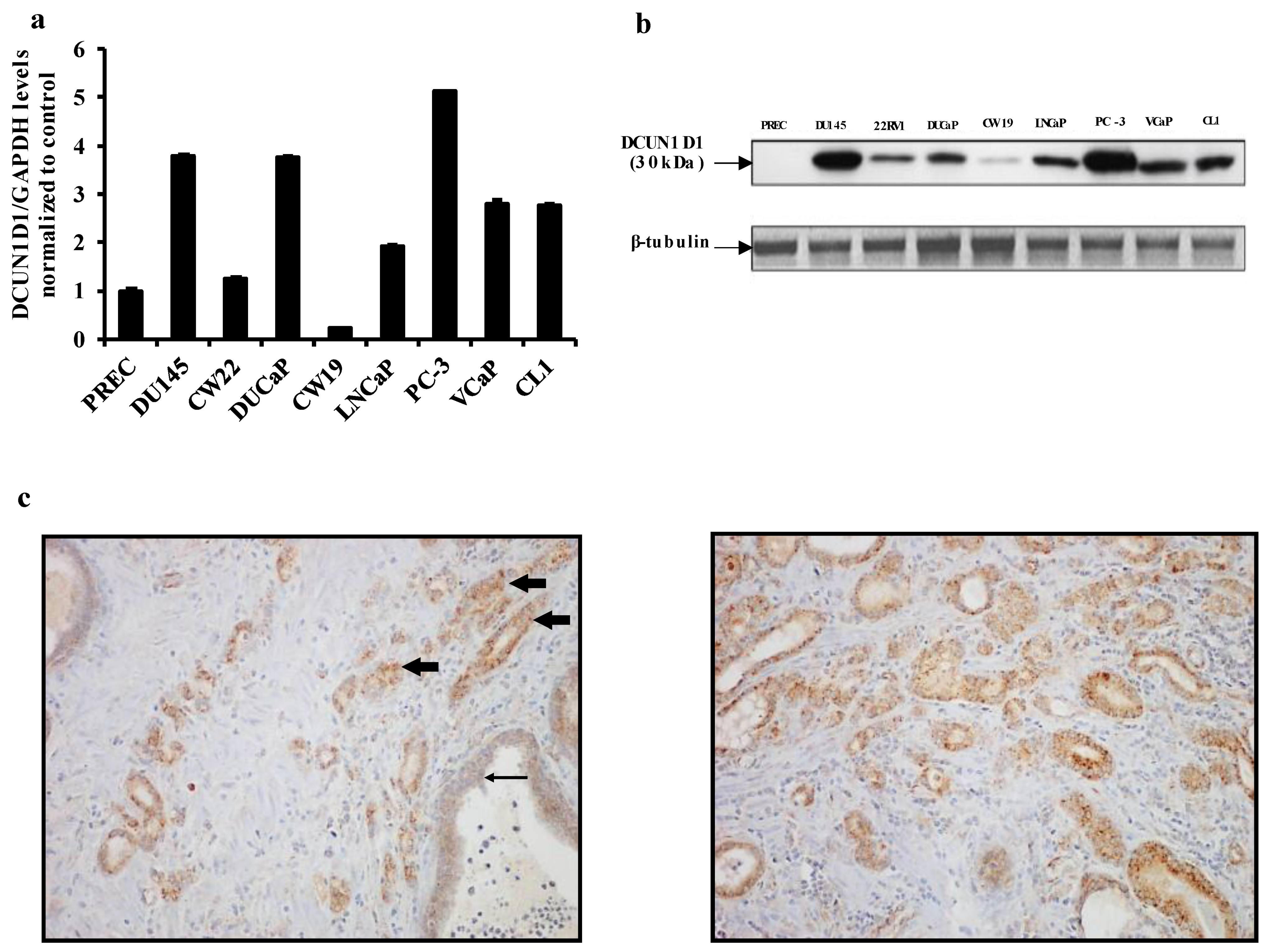
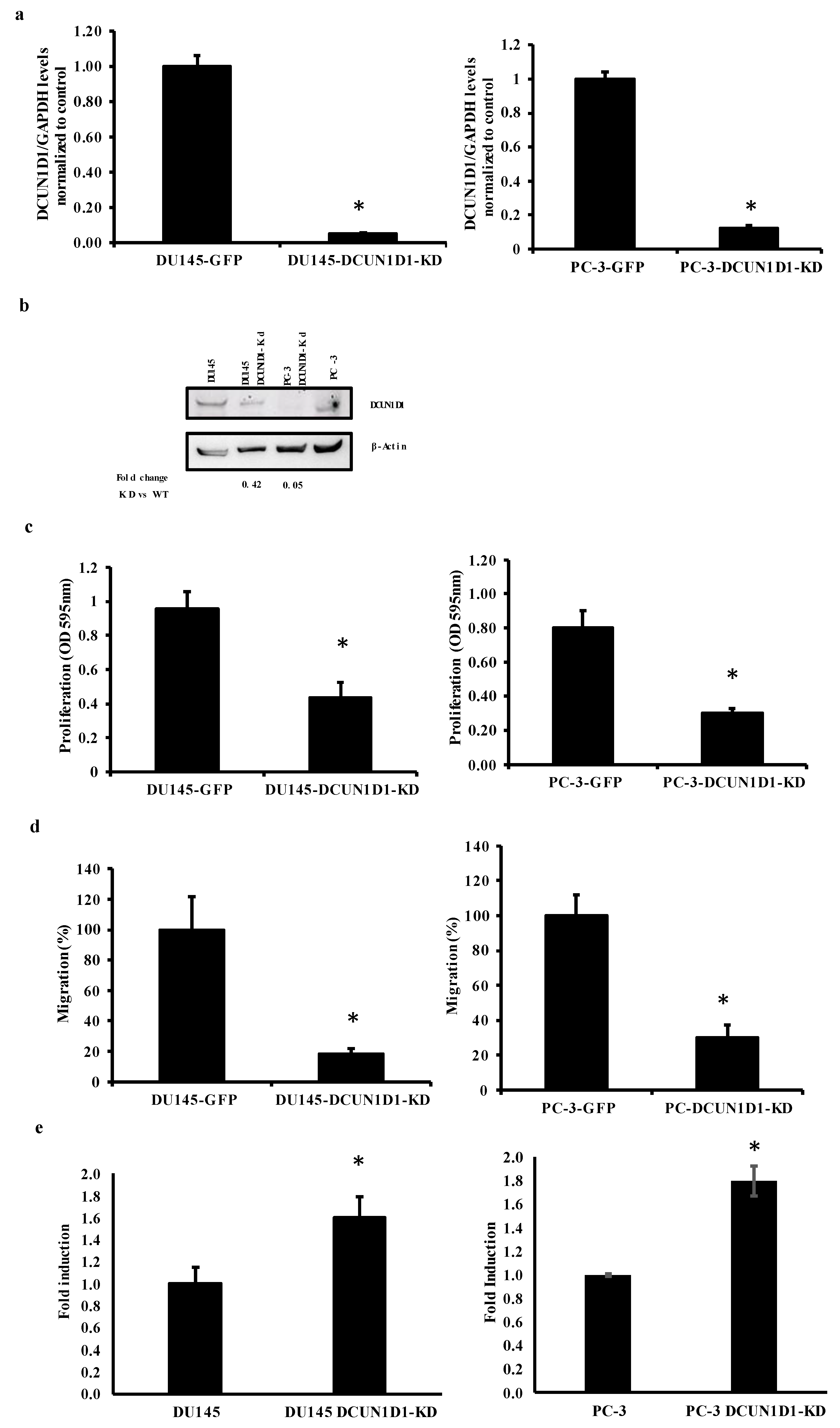
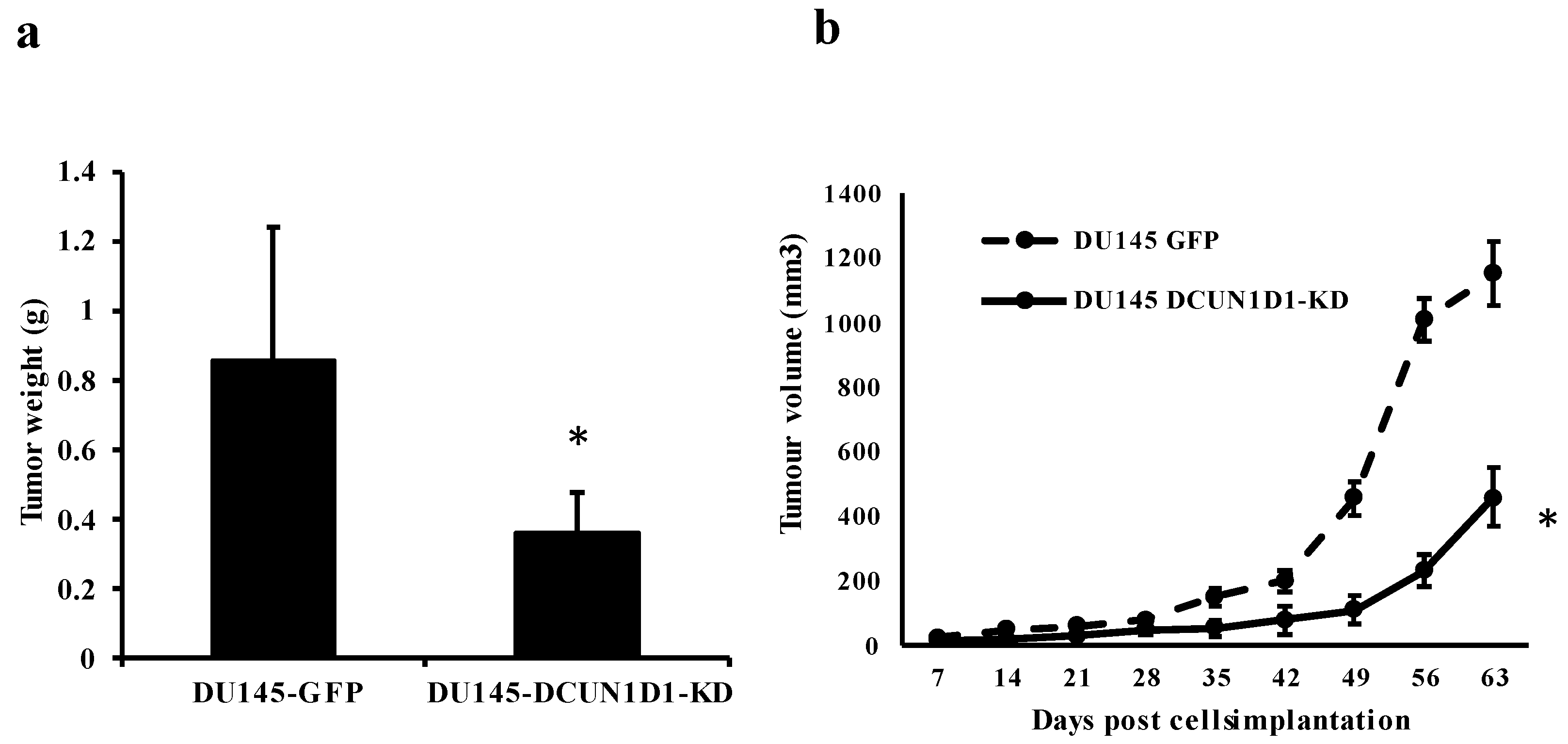
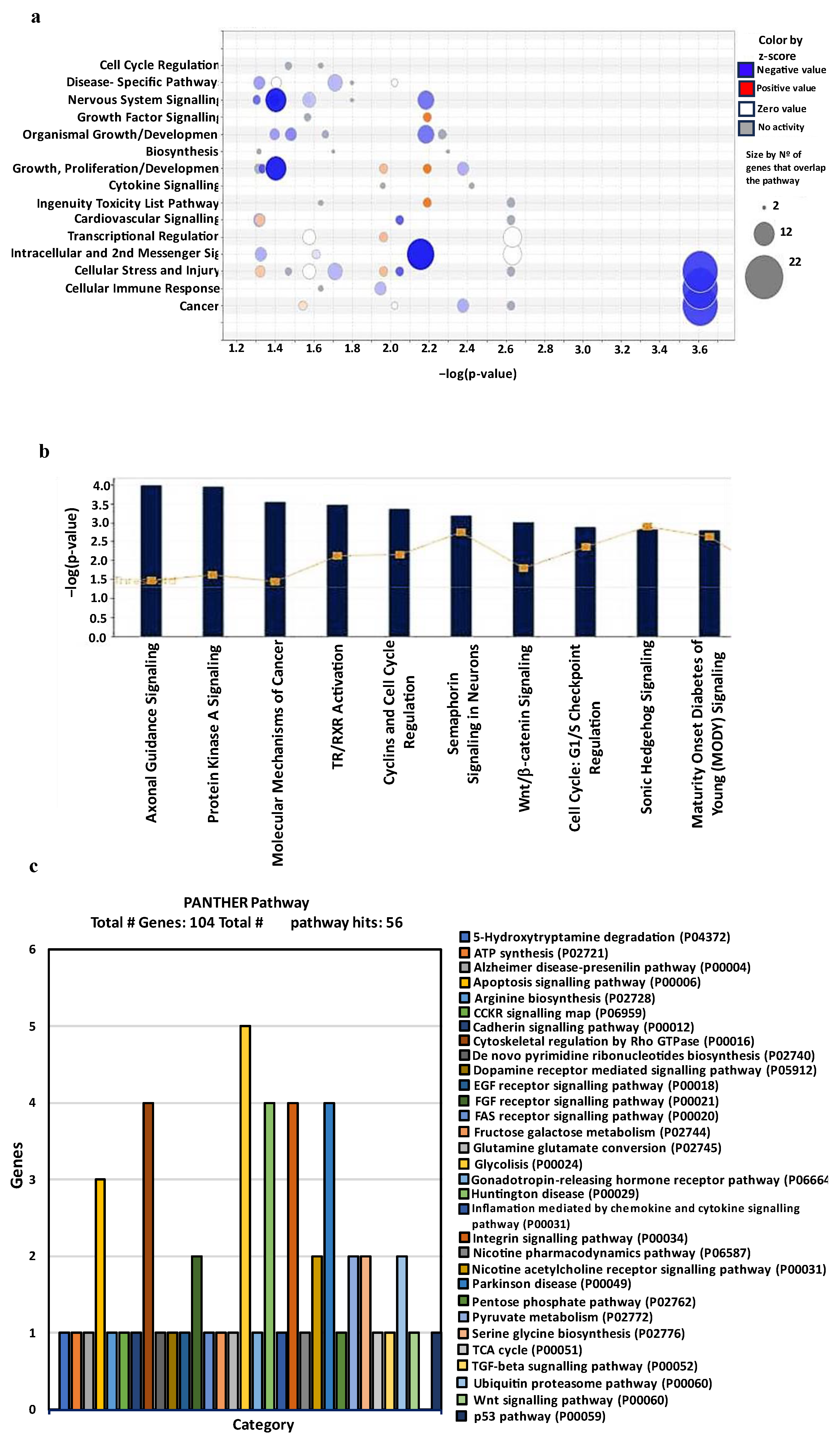

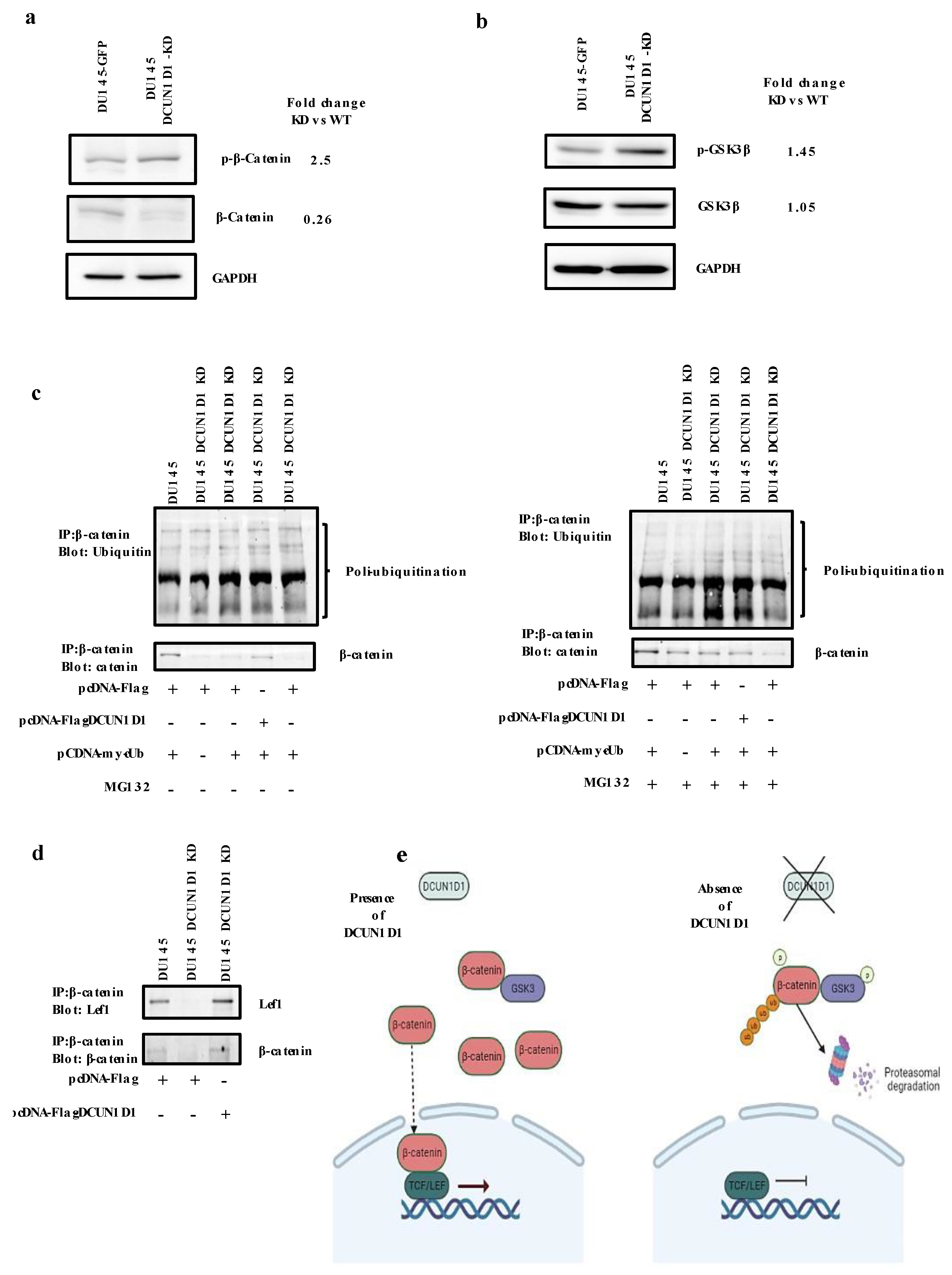
| Tissue Type | Number of Upregulated Samples/Number of Samples (%) 1 | Fold Induction Compared to Normal Prostate Tissue 2 |
|---|---|---|
| Adenocarcinoma of prostate (stage I) | 9/26 (34.6%) | 2 to 10 |
| Adenocarcinoma of prostate (stage II) | 13/29 (44.8%) | 5 to 50 |
| Adenocarcinoma of prostate (stage III) | 7/16 (43.75%) | 20 to 2000 |
| BPH | 0/10 (0%) | 0 |
| Carcinoma of bladder, transition tissue | 0/2 (0%) | 0 |
Disclaimer/Publisher’s Note: The statements, opinions and data contained in all publications are solely those of the individual author(s) and contributor(s) and not of MDPI and/or the editor(s). MDPI and/or the editor(s) disclaim responsibility for any injury to people or property resulting from any ideas, methods, instructions or products referred to in the content. |
© 2023 by the authors. Licensee MDPI, Basel, Switzerland. This article is an open access article distributed under the terms and conditions of the Creative Commons Attribution (CC BY) license (https://creativecommons.org/licenses/by/4.0/).
Share and Cite
Vava, A.; Paccez, J.D.; Wang, Y.; Gu, X.; Bhasin, M.K.; Myers, M.; Soares, N.C.; Libermann, T.A.; Zerbini, L.F. DCUN1D1 Is an Essential Regulator of Prostate Cancer Proliferation and Tumour Growth That Acts through Neddylation of Cullin 1, 3, 4A and 5 and Deregulation of Wnt/Catenin Pathway. Cells 2023, 12, 1973. https://doi.org/10.3390/cells12151973
Vava A, Paccez JD, Wang Y, Gu X, Bhasin MK, Myers M, Soares NC, Libermann TA, Zerbini LF. DCUN1D1 Is an Essential Regulator of Prostate Cancer Proliferation and Tumour Growth That Acts through Neddylation of Cullin 1, 3, 4A and 5 and Deregulation of Wnt/Catenin Pathway. Cells. 2023; 12(15):1973. https://doi.org/10.3390/cells12151973
Chicago/Turabian StyleVava, Akhona, Juliano D. Paccez, Yihong Wang, Xuesong Gu, Manoj K. Bhasin, Michael Myers, Nelson C. Soares, Towia A. Libermann, and Luiz F. Zerbini. 2023. "DCUN1D1 Is an Essential Regulator of Prostate Cancer Proliferation and Tumour Growth That Acts through Neddylation of Cullin 1, 3, 4A and 5 and Deregulation of Wnt/Catenin Pathway" Cells 12, no. 15: 1973. https://doi.org/10.3390/cells12151973
APA StyleVava, A., Paccez, J. D., Wang, Y., Gu, X., Bhasin, M. K., Myers, M., Soares, N. C., Libermann, T. A., & Zerbini, L. F. (2023). DCUN1D1 Is an Essential Regulator of Prostate Cancer Proliferation and Tumour Growth That Acts through Neddylation of Cullin 1, 3, 4A and 5 and Deregulation of Wnt/Catenin Pathway. Cells, 12(15), 1973. https://doi.org/10.3390/cells12151973






